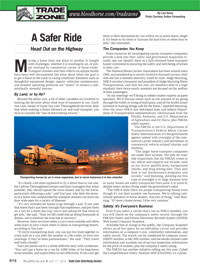Trade Zone: A Safer Ride - Click Here to Download PDF
 Moving a horse from one place to another is fraught with challenges, whether it is traveling by air, or simply overland by commercial carrier or horse trailer.
Moving a horse from one place to another is fraught with challenges, whether it is traveling by air, or simply overland by commercial carrier or horse trailer.
Transport stresses and their effects on equine health have been well documented, but what about when the goal is to get a horse to the track in racing condition? Elements such as thoughtful equipment design, regular vehicular maintenance, and prudent operating protocols are “musts” to ensure a safe, minimally stressful journey.
By Land, or by Air?
Beyond the dollar cost, a lot of other variables are involved in making the decision about what type of transport to use. Gayle Van Leer, owner of Gayle Van Leer Thoroughbred Services, feels that when making a choice between air and road transport, you have to consider the “law of diminishing returns.”
“It’s clearly a lot more expensive to fly a horse than to van one, but I advise Thoroughbred owners and farm managers that when possible, they should spend the extra money and fly the horse, particularly following a sale,” said Van Leer, who feels the stresses of a horse sale compounded by transport stresses can leave the
door wide open for a variety of illnesses.
“It’s very stressful for horses to go through a sale. If you take that horse that’s just been through that experience, and put them on a van for a multi-day trip, you’re just asking for that horse to get sick,” she said. “Your vet bill could end up being thousands of dollars, not to mention the time lost to recovery.”
However, there are times when a van is more suitable and offers some ways to save a buck when it comes to transporting horses, according to Van Leer.
“If you’re transporting foals, you can put two foals together in a box stall on a van after the weather is a bit cooler, or even two yearlings, if they’ve been pasturemates,” she said. “They travel well with a buddy.”
Van Leer points out it’s a whole different story with racehorses. “You can’t put a horse on a van for 3,000 miles, or for long hours in hot weather, and expect them to race effectively. If you can’t get them to their destination by van within six or seven hours, forget it. It’s better to fly them or increase the lead time on when they’re sent,” she concluded.
To continue reading, click the "Download" button at the bottom of this page.
Sponsors:
Dandy Products (http://www.dandyproductsinc.com/)
Sallee Horse Vans (http://www.salleehorsevans.com/)
Turnbow Trailers (http://www.turnbowtrailers.com/)
Spalding Laboratories (http://www.0213.spalding-labs.com/)
Archives:
Parasite Control - May 22, 2010
AAEP Focus on Disease Treatment, Prevention - April 24, 2010
AAEP 2009: Focus on Horse Health News - March 20, 2010
AAEP 2009: The Latest on Lameness Treatments - February 13, 2010
Foal Health - January 9, 2009
Common Reproductive Problems in Mares - December 5, 2009
The Third Trimester - November 14, 2009
Ready to Run - October 31, 2009
Feeding For the Ages - September 19, 2009
Transportation Tips - September 5, 2009
Disease Control Yearly Planner - August 8, 2009
Foot Flops & Fixes - July 25, 2009
Get Ready - June 26, 2009
Therapy For Thoroughbreds - May 5, 2009
Dirt or Synthetic - Which is Safer? - April 25, 2009
AAEP: Focus on Horse Health News - March 21, 2009
Infectious Disease at the AAEP Convention - February 21, 2009
When Foaling Goes Wrong - December 6, 2008
Feeding the Pregnant Mare - November 15, 2008
Broodmare Vaccinations - November 1, 2008
Transport Stress in Horses - October 18, 2008
View more...




